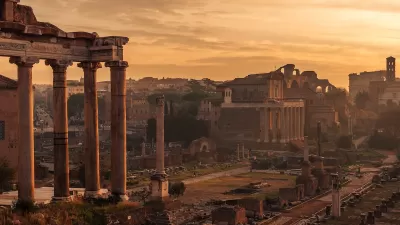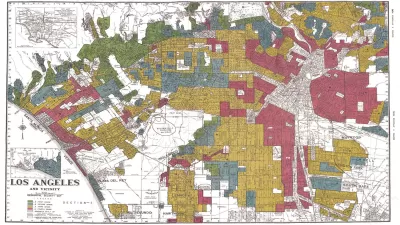The homes designed by architect John Lautner have appeared often in films, many times as characters themselves and many times associated with villains. Adam Baer examines what it is about Lautner's designs that inspire associations with evil.
Called “the world’s second-best architect” by his former employer Frank Lloyd Wright, and "a god" by Frank Gehry, it seems ironic that for an architect who "was first committed to building middle-class homes" and "lived in a workaday Hollywood apartment", his life's work is now mostly associated with notorious film villains and outcasts.
"Lautner homes—fluid, organic playgrounds for space and light, set in the elements—have been used in over a dozen movies, often as the homes of solitary men, most of them ne’er-do-wells," writes Baer. "The list of homes as film stars includes but is not limited to: the Elrod House in Palm Springs (fight scene, Diamonds Are Forever, Sean Connery vs. scantily clad Bond Girls in a roundtop room with a view of the Coachella Valley desert); the Garcia House, which literally looks like a glass eye built into the Hollywood Hills (and whose replica was dragged off a cliff by Mel Gibson in Lethal Weapon 2); the Jacobsen House, a hexagonal, steel-framed backdrop for a shootout between Paul Newman and James Garner in the 1998 crime mystery Twilight."
The most famous of Lautner's film stars is the Chemosphere, "an octagonal pod-like home with a 360° view, thrust above the hills on a single pole plunged deep into a steep, sloping lot," that's been a central character in films and television shows ranging from Brian de Palma’s Body Double to Charlie’s Angels to The Simpsons.
So what is it about his designs that inspire filmmakers and location scouts, and embody or converse with the often mischievous characters that inhabit them.
"Whether it’s the sculptural concrete, the walls of glass, or the surprising angles of steel and wood, the elements of Lautner’s homes appeal immediately to the human spirit," says Baer. "Lautner created spaces that invite us to be (or at least think) primal inside them, and therefore, in some sense, to act free, even play. His homes represent an independent, less systematic approach to modernism—honoring modernism more intrinsically than the homes of his forebears by following the contours of the earth as opposed to the linear blueprints of the more strict International Style."
"Despite their use in film, they evoke nothing nefarious; if anything, they project an exuberance for life, a dialogue with nature. Quite simply, they encourage imagination."
FULL STORY: If You Were Cool, Rich, or Bad Enough to Live Here, You'd Be Home

Study: Maui’s Plan to Convert Vacation Rentals to Long-Term Housing Could Cause Nearly $1 Billion Economic Loss
The plan would reduce visitor accommodation by 25,% resulting in 1,900 jobs lost.

North Texas Transit Leaders Tout Benefits of TOD for Growing Region
At a summit focused on transit-oriented development, policymakers discussed how North Texas’ expanded light rail system can serve as a tool for economic growth.

Why Should We Subsidize Public Transportation?
Many public transit agencies face financial stress due to rising costs, declining fare revenue, and declining subsidies. Transit advocates must provide a strong business case for increasing public transit funding.

A Visual Celebration of Manhattan’s Chinatown Elder Community, Through Food
Lanterns, cafeteria trays, and community connection take center stage in this stunning photo essay.

How to Make US Trains Faster
Changes to boarding platforms and a switch to electric trains could improve U.S. passenger rail service without the added cost of high-speed rail.

Columbia’s Revitalized ‘Loop’ Is a Hub for Local Entrepreneurs
A focus on small businesses is helping a commercial corridor in Columbia, Missouri thrive.
Urban Design for Planners 1: Software Tools
This six-course series explores essential urban design concepts using open source software and equips planners with the tools they need to participate fully in the urban design process.
Planning for Universal Design
Learn the tools for implementing Universal Design in planning regulations.
City of Santa Clarita
Ascent Environmental
Institute for Housing and Urban Development Studies (IHS)
City of Grandview
Harvard GSD Executive Education
Toledo-Lucas County Plan Commissions
Salt Lake City
NYU Wagner Graduate School of Public Service




























